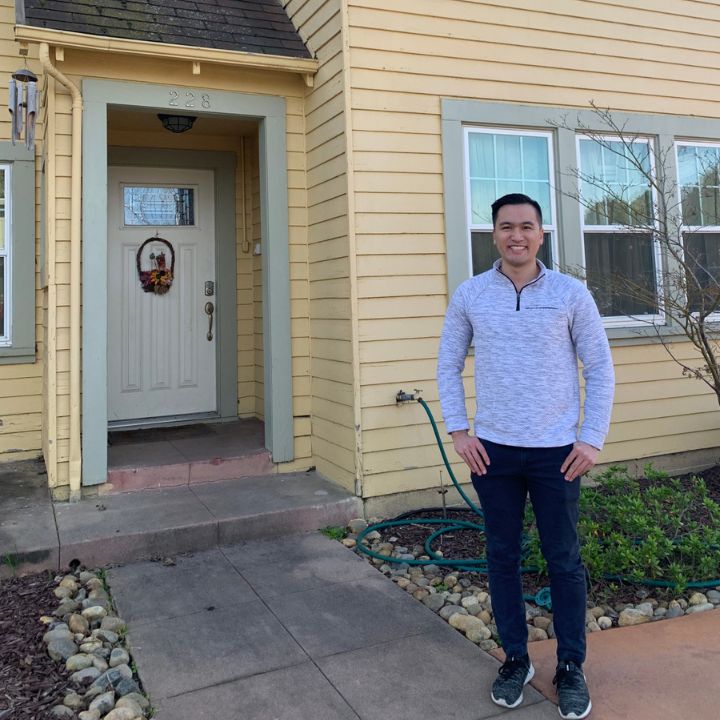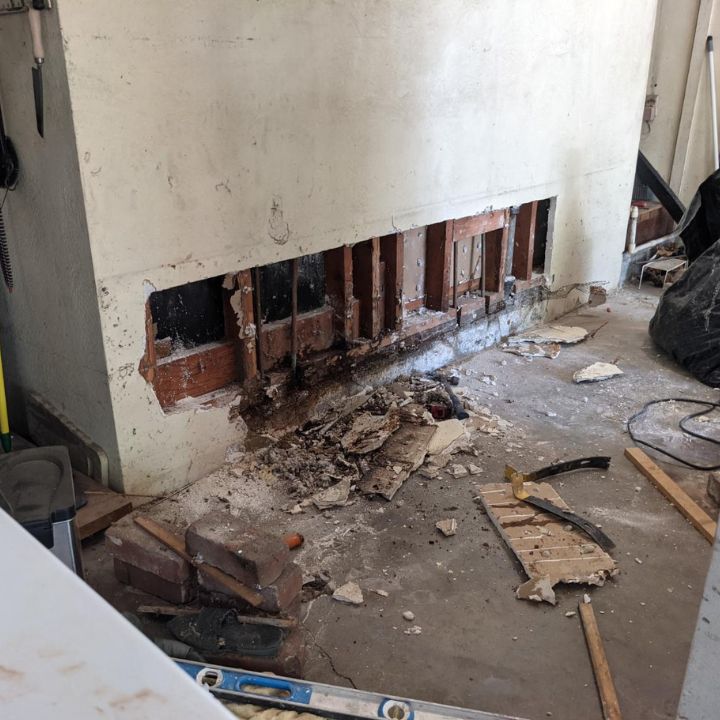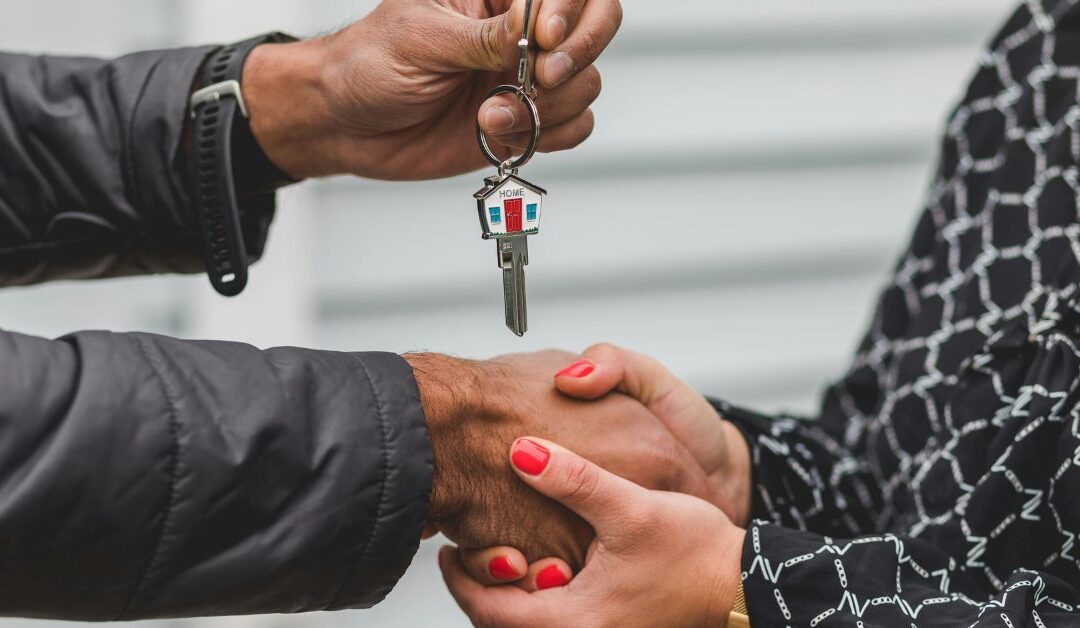How do you buy rental property as a beginner?
Here, you’ll learn:
- What the most profitable rental properties are
- How to finance your rental property
- How to choose the right property
- And so much more!
Want to learn more? Read on!
How to prepare for buying your first rental property
You want to buy your first rental property…but you’re not sure exactly how to do it.
Can you afford to buy a rental property?
Is buying rental property a good way to make money?
How do you ensure a good cash flow?
Here, you’ll learn exactly how to choose the right property, find reliable tenants, and ensure high cash flow on your property.
I’ve created this guide based on my own experience as a real estate investor. When I first started, I didn’t have a clue about buying rental properties…leading to $30,000 in losses and negative cash flow. Those are the types of mistakes I want to help you avoid – with the strategies I share below.
Let’s start with understanding why a rental property might be the right choice for you.
Understand your “why”
First of all, before you start investing in rental properties, understand why you’re doing it.
Maybe you want to make a higher income…
Landlords typically make $10,000 annually per rental unit. They earn $35,000 more than the average household and use less than 40 hours/month managing their properties (20% spend 4 hours).
I grew my own investment portfolio that generates multiple six figures. It’s allowed me to quit my day job and do this full time.
I love the freedom and flexibility it brings – I’m able to travel more and get to do something I love every day.
However, an even stronger motivation might be to create a legacy and opportunities for your family.
My own grandpa built an investment portfolio that helped him retire early and paid for his grandkids’ college education. He has always been my biggest inspiration – because I saw what a profound impact his work had on his family.
Me and one of my properties:

But to start investing, you first need to understand your finances. That’s what we’ll look at next.
Assess your finances
Start by understanding if you have enough money saved up to finance your property.
Rental properties typically require a down payment of 15%-25%. Properties you live in require a lower down payment, though (as low as 3%).
But what should you do if you don’t have money for a down payment?
If you don’t have funds for a full down payment, you can “house hack.” In other words, you live in the property and rent rooms to other people. As this is your home, you get to tap into a lower down payment.
That’s what I did early on. I lived in my property while I rented out my spare rooms to tenants.
Here’s how I did it:
Understand your metrics
You also need to understand how much money your property will make. Look at vacancy rates and property values in your target area to see where you can find properties with high demand and stable rental income.
To do so, you need to understand metrics like ROI and cash flow.
- Return on investment (ROI): This number tells you how much you’ll earn on your investment. Calculate it with this formula: Net profit/cost of investment x 100.
- Cash flow: Your cash flow is your cash income minus your operating expenses (including vacancy, mortgage payments, taxes, and so on) over 12 months. If you have cash left over, your cash flow is positive. Calculate it with this formula: Rental income – expenses.
- Cap rate: Cap rate shows you how much you could make or lose if you buy a property. Calculate it with this formula: (Net operating income/Current market value) x 100.
In general, the 2% rule can help you understand what type of income and cash flow you’re looking at. The monthly rent you ask for should be at least 2% of the purchase price for you to get a positive cash flow.
Choose a real estate investment strategy
You can use different investment strategies, depending on how much risk you are willing to take, how passive you want to be, and how much income you want to make.
You can either be a hands-on landlord or choose REITs for a more passive approach. Read more about different strategies here.
I personally use student housing investments as my investment strategy.
In other words, I invest in off-campus student housing and rent by the room to students. There are plenty of benefits to this model – from higher rents because I can rent out rooms separately to lower risk because student housing tends to be in demand, regardless of what the economy looks like.
I personally also enjoy renting to students and helping them find high-quality, fairly priced accommodation.
Get the right support
Buying and managing a rental property requires that you get help from different people. You don’t necessarily need to work with all of these, but rental property transactions often involve:
- Real estate agents
- Mortgage brokers
- Property inspectors
- Lawyers
- Property managers
Next, let’s look at what buying property actually requires from you.
How to buy rental property for beginners
Here are the steps you need to take to buy rental property:
- Finance your property
- Find the right property
- Do your due diligence
- Make an offer
- Close on the property
First up:
Financing your property.
Finance your rental property
To finance your property, you can either start with a conventional bank loan if you have a down payment of 15%-20%.
Most often, lenders look at your credit score, debt-to-income ratio, and estimated rental income to calculate your down payment.
You also typically need a credit score of at least 620 to qualify for these loans.
However, one of the biggest mistakes you can make here is to not look at different lenders. Freddy Mack estimates that people save $1,200 per year by shopping lenders. So, on a 30-year loan, you’d save $36,000 in interest payments.
You could even ask lenders to beat each other’s rates; a strategy that I’ve seen help people save $8,000 right away.
That said, there are other ways to finance your property. After all, these options can help you invest in a rental property without needing a down payment.
What are they? Here are some of your options:
Federal Housing Administration (FHA) or Veteran Affairs (VA) loans
FHA loans are government-backed mortgages that are designed for first-time buyers.
You don’t need to put down as much money for a down payment – around 3%. Sellers are also allowed to offer seller credits and they can help you structure a deal where closing cost credits offset your down payment.
But FHA loans are offered to homeowners, so if you choose this option, you need to live in the property. You could do that and house hack by renting out the other rooms.
VA loans are another option.
VA loans are available to eligible veterans, active-duty service members, and their families. They often don’t require any down payment or private mortgage insurance.
However, they have specific property eligibility requirements. Plus, they’re only available for homeowners, so, again, you’d use this loan to house hack.
I talk more about FHA and VA loans in this guide.
Private lenders
Another option is to get a loan from friends, family, or private investors. The terms and rates can vary a lot. However, especially private investors tend to charge high interest rates and require more collateral than traditional lenders.
Hard money loans
Hard money loans are short-term loans secured by the property. So the loans focus more on the property’s value than your ability to pay back.
They tend to be high-interest loans, as they’re financed by private lenders. Typically, they’re used by rental property investors who flip properties and other shorter-term schemes.
JV partnerships
I’ve personally used this strategy to finance some of my investments and partnered with my uncle. While my uncle financed the down payment 100%, we split the cash flow 50-50.
My role in the partnership was to find the property, market it to tenants, and manage it. Which was a win-win for both of us – my uncle put in the money, but then got to collect passive cash flow checks every month. And I got to invest in real estate without putting down money upfront.
I talk more about the strategy here:
Choose a location and property
The location of your property determines how much rent you can collect.
Typically, locations with growing populations or a revitalization plan are good investments. Look for good schools, a job market, amenities close by (restaurants, parks…), and low crime rate to ask for higher rents.
Also, look at things like the condition of the property, local regulations, and low property taxes.
For example, when I invest in student housing, I look at areas where there are top colleges, lots of new job opportunities, and top hospitals.
These factors tend to attract high-income earners and higher rents. If there are jobs and colleges close by, the area will most likely continue to attract people despite a poor economy or national housing trends.
I also look at newer houses that are over 1,500 sq/ft, especially if there are many bedrooms or spare rooms that can be converted into bedrooms to increase cash flow.
However, I don’t invest in old houses even if they are cheaper upfront. They often have old pipes, lead paint, and other issues that might cost a lot to update.
You can find properties on real estate property sites like Zillow and Trulia.
When you find a property, use Rentometer to assess cash flow for your property. Pop in the address of your property to see what rents tend to be in the area you’re considering buying in.
And to understand how much cash flow your property will make, calculate your costs (mortgage, maintenance expenses, and vacancy rates). Note that there are other costs, but for simplicity, those pretty much cover the costs for your first rental property.
Then, deduct that number from the estimated rent. That’s how you get cash flow.
I personally try to make at least $1,000 a month per property in cash flow if I’m buying in a more expensive area and $2,000 in an area with lower housing costs.
I walk you through more examples here:
Do your due diligence
Before buying anything, you need to do your due diligence.
This includes:
- Visiting the property
- Conducting inspections
- Title searches
- Other evaluations
Due diligence helps you assess the property’s condition and identify any issues so that you can estimate your ROI and cash flow.
In fact, one of the BIGGEST mistakes you can make is to skip this step.
I’m speaking from experience – I bought my first property without doing due diligence.
I ended up sitting on the phone with my tenant at 11PM at night because the kitchen sink was overflowing and the water was flowing down on the kitchen floor, while the bathroom drain was pouring out water on the bathroom floor.
So, in the middle of the night, I had to find a plumber to fix the sewage line and a cleanup service to clean it up. The bill was $9,000.
Ultimately, that property ended up costing me five figures in unexpected repairs. And I had negative cash flow…for the next two years!
A bit of the damage:

Had I inspected the property first, I would’ve realized there were roots sticking in the pipes, which had broken down.
I could’ve asked the seller to fix the sewage line before buying or walked away from the deal. Either way, I wouldn’t have had those expenses, which significantly set me back.
So, do your research before investing in a property.
I walk you through how I analyze a real property here:
Make an offer
Then, if the property is a good fit, it’s time to negotiate the price and terms with the seller.
While this step is relatively simple, it’s not necessarily easy…because people tend to get really stuck in ruminating, analysis paralysis, and fear.
But there are ways to make this step less scary.
First, by doing your due diligence so that you know your investment is as good as it gets.
You can also choose a less risky strategy – for example, by investing in student housing.
And third, prepare yourself. House hack if you need to and build up an emergency fund before you make an investment.
I personally worked as a Pharmacist full-time (and took on weekend shifts to increase my earnings) and lived with my parents before I bought a property and started house hacking. Now, you don’t necessarily need to live with your parents but look at ways you can earn more money and save more.
Close on the property
Closing on a property involves:
- Finalize your loan: You’ll get final loan documents from your lender.
- Get homeowner’s insurance: Get homeowner’s insurance and send proof to your lender and escrow agent.
- Title search and insurance: A title company verifies the property’s ownership and searches for any liens or claims.
- Review closing documents: The Closing Disclosure outlines final costs, including any outstanding property taxes.
- Get a final walkthrough: Go through the property to ensure everything is as you’ve agreed.
- Sign the paperwork: Sign all closing documents to get ownership transferred to you.
- Fund disbursement: Once your paperwork is signed, the lender sends loan funds to the escrow agent who, in turn, sends them to the seller/other parties.
- Receive key and titles: Once your funds have been sent, you get the keys and the official title document.
How to manage your rental property
To rent your property, you need to set the rent, find reliable tenants, and maintain the property. We’ll look at each of these steps here below.
Set the rent
You can’t just decide what rent feels good to charge. Instead, you need to go with what the market decides.
And to do that, take the steps we talked about above to find the right property. See what the average rent is in that area for the type of property you want to buy.
I typically look for houses with up to three bedrooms per bathroom. So, if you can, get a house with at least three bedrooms, calculate your costs, and understand if that’s a good area to invest in.
Find tenants
One of the most burning questions people tend to have is, “How do I find reliable tenants?”
And it’s fair because you don’t want to end up in a situation where you have to deal with tenants who behave badly and become a headache.
First, figure out what things are important to your target tenants to attract the right people to your property. For example, as I rent to college students, I know they value things like good internet and a secure neighborhood.
Then, you should advertise as much as possible to get in front of them – at least once a week and on as many places as possible (Facebook groups, campus bulletins, Craigslist…).
That way, you have a constant stream of tenants coming in, and you can choose the best tenants.
Last, identify tenants who are needy or picky – those who ask for things outside the lease, are a bit rude, or expect unreasonable things from you as a landlord.
Also, look at how respectful they are in their communication with you (saying thank you, being responsive, and so on). That type of behavior tends to indicate how well they’ll communicate with you as tenants.
Get proof of income from them, too, so that you know they have the ability to pay. As I rent to college students, I ask their parents to be co-signers.
Here’s more on picking the right tenants:
Maintain the property
You can either find a property manager to manage your property or self-manage. There are pros and cons to both options. While self-managing takes work, a property management service will quickly eat up your cash flow – property managers tend to ask for 8%-12% of the rents you collect.
I self-manage – but I do so in a stress-free way using what’s called “tenant empowerment.”
This system gives tenants responsibilities that help them manage your property.
For example, if they’re worried about the security, they might go and buy a security camera, which you then reimburse. Or if they think another tenant is too loud, they start by talking to that person directly.
Other things you can do is to set the utilities under one tenant’s name so that they then ask for that money from the other tenants. Same goes for the internet – if the internet is down, you don’t have to act as a middleman.
It’s a win-win – tenants don’t have to wait for me to fix situations as they can do it themselves.
Of course, there are things you can’t completely sign off on, like if major repairs are needed and you need to inspect the property. But those are rare and you can get rid of most day-to-day issues by following these steps.
For more, take a look at my quick video here:
How much profit should you make on a rental property?
10-15% is considered a good profit margin on rental properties. However, this depends on the type of property you buy and your strategy.
And there are plenty of different types of rental properties you can invest in. I go through the most common types here. They include house flipping, REITs, and more.
Buying and renting out rental properties is a great option. You’ll get three clear benefits from this type of investment – cash flow, appreciation, and tax benefits.
Personally, I’ve built a real estate portfolio that’s worth seven figures and brings in multiple six figures every year.
You can either rent out property long-term (this is what I do). Or, you can do short-term rentals on platforms like Airbnb.
I use the student housing model where I invest in student housing off-campus. I maximize my profits as I rent by the room versus to a single person or family, offer great accommodation to students, and minimize my risk because student housing tends to be something that’s always in demand. You can read more about it here.
Risks and rewards
What are the pros and cons of buying rental property? Here are the risks and rewards:
Rewards
- Passive income: Rent can supplement your income or become your primary income. For example, I quit my job as a Pharmacist and am now a full-time real estate investor.
- Appreciation: Property values tend to increase, so when you sell your property, you can make a significant return on your investment.
- Tax benefits: Rental income can offer different tax deductions.
- Asset: Your real estate is a physical asset.
Risks
- Vacancy rates: You have to pay all the costs even if your property is empty. However, you can protect yourself against these risks by choosing the right type of property, strategy, and being actively involved in finding tenants.
- Maintenance: You might have unexpected repairs and ongoing maintenance costs. The best way to avoid these costs is to do your due diligence before you buy your property.
- Problematic tenants: Tenant horror stories can be both costly and extremely stressful. But if you screen tenants carefully before renting to them, you will most likely not need to deal with this type of tenant.
- Lack of liquidity: Selling your property takes time and depends on market fluctuations, so you shouldn’t use money you’ll need in the short term.
Next steps
There you have it! That’s how to buy rental property – even if you’re a beginner.
Investing in rental property can be straightforward…But there’s a lot of fear and analysis paralysis involved.
That’s what I hear my students say all the time.
But if you want to make this the year you invest in your first rental property, let’s talk.
I offer my experience of building a portfolio that makes multiple six-figures (and helped me quit my job) as a real estate coach.
Learn more:


